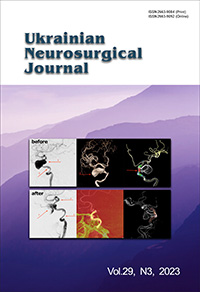Own experience of using holographic neuronavigation using an augmented reality helmet in neurosurgery
DOI:
https://doi.org/10.25305/unj.284245Keywords:
mixed reality, neuronavigation, preoperative planningAbstract
Objective: to optimize surgical access to intracranial lesions (tumors, arteriovenous malformations, cysts, etc.) by using a holographic neuronavigation system with augmented reality helmet.
Materials and methods: The study included thirty-four patients who underwent cerebral neurosurgical interventions. Creation and clinical use of mixed reality neuronavigation (MRN) system holograms was possible in all cases, which allowed accurate localization of lesions. The additional time required for synchronizing the MRN system with the clinical environment was estimated, which decreased with the number of MRN system uses. Operators evaluated the effectiveness of the technology and in most cases provided positive evaluations after use.
Results: A semi-automatic MRN recording system on HoloLens smart glasses has been developed and tested for accuracy and performance. 34 patients with intracranial lesions were prospectively included in the study. Three-dimensional holograms of lesions, markers, and surrounding anatomical landmarks based on multimodal imaging were generated for each patient and then imported into the MRN system in AR helmet. After point recording, holograms were projected onto the patient’s head and observed through the AR helmet during the planning and conducting of surgical interventions.
Conclusions: In this small pilot study, the authors found that mixed reality neuronavigation system MRN can be applied in the workflow of a neurosurgical operating room and is a possible method of preoperative identification of lesion boundaries for surgical access planning. Future studies are needed to identify strategies to improve and optimize the accuracy of MRN system.
References
1. Besharati Tabrizi L, Mahvash M. Augmented reality-guided neurosurgery: accuracy and intraoperative application of an image projection technique. J Neurosurg. 2015 Jul;123(1):206-11. [CrossRef] [PubMed]
2. Mishra R, Narayanan MDK, Umana GE, Montemurro N, Chaurasia B, Deora H. Virtual Reality in Neurosurgery: Beyond Neurosurgical Planning. Int J Environ Res Public Health. 2022 Feb 2;19(3):1719. [CrossRef] [PubMed] [PubMed Central]
3. Guha D, Alotaibi NM, Nguyen N, Gupta S, McFaul C, Yang VXD. Augmented Reality in Neurosurgery: A Review of Current Concepts and Emerging Applications. Can J Neurol Sci. 2017 May;44(3):235-245. [CrossRef] [PubMed]
4. Incekara F, Smits M, Dirven C, Vincent A. Clinical Feasibility of a Wearable Mixed-Reality Device in Neurosurgery. World Neurosurg. 2018 Oct;118:e422-e427. [CrossRef] [PubMed]
5. Tepper OM, Rudy HL, Lefkowitz A, Weimer KA, Marks SM, Stern CS, Garfein ES. Mixed Reality with HoloLens: Where Virtual Reality Meets Augmented Reality in the Operating Room. Plast Reconstr Surg. 2017 Nov;140(5):1066-1070. [CrossRef] [PubMed]
6. van Doormaal TPC, van Doormaal JAM, Mensink T. Clinical Accuracy of Holographic Navigation Using Point-Based Registration on Augmented-Reality Glasses. Oper Neurosurg (Hagerstown). 2019 Dec 1;17(6):588-593. [CrossRef] [PubMed] [PubMed Central]
7. Frantz T, Jansen B, Duerinck J, Vandemeulebroucke J. Augmenting Microsoft’s HoloLens with vuforia tracking for neuronavigation. Healthc Technol Lett. 2018 Oct 4;5(5):221-225. [CrossRef] [PubMed] [PubMed Central]
8. Cutolo F, Meola A, Carbone M, Sinceri S, Cagnazzo F, Denaro E, Esposito N, Ferrari M, Ferrari V. A new head-mounted display-based augmented reality system in neurosurgical oncology: a study on phantom. Comput Assist Surg (Abingdon). 2017 Dec;22(1):39-53. [CrossRef] [PubMed]
9. Li Y, Chen X, Wang N, Zhang W, Li D, Zhang L, Qu X, Cheng W, Xu Y, Chen W, Yang Q. A wearable mixed-reality holographic computer for guiding external ventricular drain insertion at the bedside. J Neurosurg. 2018 Oct 1:1-8. [CrossRef] [PubMed]
10. Cabrilo I, Bijlenga P, Schaller K. Augmented reality in the surgery of cerebral aneurysms: a technical report. Neurosurgery. 2014 Jun;10 Suppl 2:252-60; discussion 260-1. [CrossRef] [PubMed]
11. Condino S, Montemurro N, Cattari N, D’Amato R, Thomale U, Ferrari V, Cutolo F. Evaluation of a Wearable AR Platform for Guiding Complex Craniotomies in Neurosurgery. Ann Biomed Eng. 2021 Sep;49(9):2590-2605. [CrossRef] [PubMed]
Downloads
Published
How to Cite
Issue
Section
License
Copyright (c) 2023 Volodymyr O. Piatykop, Vladyslav I. Kaliuzhka, Mykyta A. Markevych, Iurii O. Babalian, Maksym M. Khaustov

This work is licensed under a Creative Commons Attribution 4.0 International License.
Ukrainian Neurosurgical Journal abides by the CREATIVE COMMONS copyright rights and permissions for open access journals.
Authors, who are published in this Journal, agree to the following conditions:
1. The authors reserve the right to authorship of the work and pass the first publication right of this work to the Journal under the terms of Creative Commons Attribution License, which allows others to freely distribute the published research with the obligatory reference to the authors of the original work and the first publication of the work in this Journal.
2. The authors have the right to conclude separate supplement agreements that relate to non-exclusive work distribution in the form of which it has been published by the Journal (for example, to upload the work to the online storage of the Journal or publish it as part of a monograph), provided that the reference to the first publication of the work in this Journal is included.









